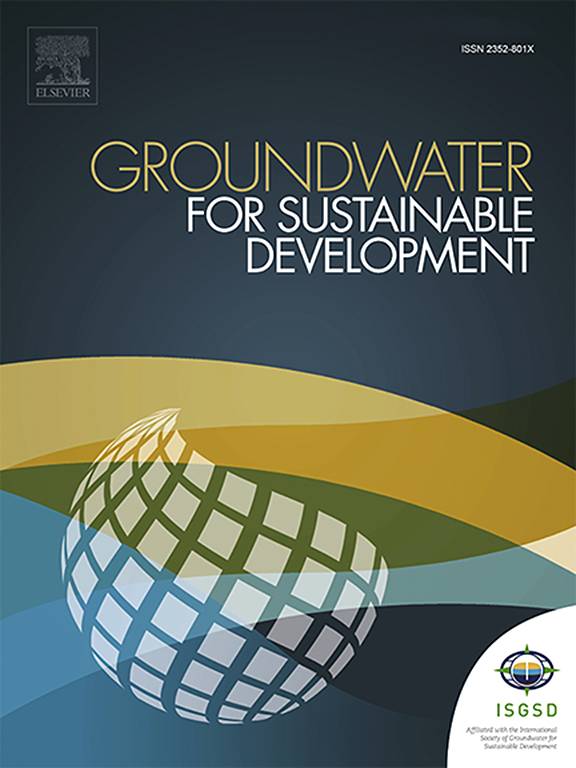华北平原集约化农业条件下水动力学和地下水补给的长期模拟
IF 4.9
Q2 ENGINEERING, ENVIRONMENTAL
引用次数: 0
摘要
集约化农业地区地下水补给日益受到气候变化和人类活动的影响。在华北平原(NCP),数十年的集约化农业导致了持续的过度开采,地下水位以每年约85厘米的速度下降至20-50米深。通过厚渗透带进行垂直补给的量化是地下水可持续管理的必要条件。利用48米沉箱观测站的体积含水量和基质势的现场观测数据,我们校准并验证了Hydrus-1D模型,然后对30米厚的渗透带进行了观测约束的长期模拟(1990-2023)。该模式再现了对地表水输入的深度递进响应:通量变异性在根区最大,而深层响应更稳定,特别是在极端降雨序列之后。一个持续的零通量面出现在4米深度附近。在34年的重建中,年平均潜在补给量为202 mm/yr,相当于平均深入渗速率为0.51 mm/d。NCP的地下水补给主要发生在夏季降雨期间,极端降水事件使垂直水通量相对于降雨分布均匀的情景增加了约4.6 - 7.6%。研究结果阐明了集约化农业条件下厚渗透带的垂直水运动规律,为区域补给估算和地下水可持续管理提供了实践指导。本文章由计算机程序翻译,如有差异,请以英文原文为准。

Observation-constrained long-term simulations of water dynamics and groundwater recharge under intensive agriculture in the North China Plain
Groundwater recharge in intensively farmed regions is increasingly influenced by climate change and human activities. In the North China Plain (NCP), decades of intensive agriculture have driven persistent overextraction, with the groundwater table declining by ∼85 cm/yr to depths of 20–50 m. Quantifying vertical recharge through the thick vadose zone is essential for sustainable groundwater management. Using in-situ observations of volumetric water content and matric potential from a 48-m caisson observatory, we calibrated and validated Hydrus-1D model, and then produced observation-constrained long-term simulations (1990–2023) for a 30-m thick vadose zone. The model reproduces depth-progressive responses to surface water inputs: flux variability is largest in the root zone, whereas deeper layers respond more steadily, especially following extreme rainfall sequences. A persistent zero-flux plane occurs near 4 m depth. Over the 34-year reconstruction, the mean annual potential recharge is 202 mm/yr, equivalent to an average deep infiltration rate of 0.51 mm/d. Groundwater recharge in the NCP predominantly occurs during summer rainfall, with extreme precipitation events enhancing vertical water fluxes by approximately 4.6–7.6 % relative to scenarios with evenly distributed rainfall. These results clarify vertical water movement in thick vadose zones under intensive agriculture and provide practical guidance for regional recharge estimation and sustainable groundwater management.
求助全文
通过发布文献求助,成功后即可免费获取论文全文。
去求助
来源期刊

Groundwater for Sustainable Development
Social Sciences-Geography, Planning and Development
CiteScore
11.50
自引率
10.20%
发文量
152
期刊介绍:
Groundwater for Sustainable Development is directed to different stakeholders and professionals, including government and non-governmental organizations, international funding agencies, universities, public water institutions, public health and other public/private sector professionals, and other relevant institutions. It is aimed at professionals, academics and students in the fields of disciplines such as: groundwater and its connection to surface hydrology and environment, soil sciences, engineering, ecology, microbiology, atmospheric sciences, analytical chemistry, hydro-engineering, water technology, environmental ethics, economics, public health, policy, as well as social sciences, legal disciplines, or any other area connected with water issues. The objectives of this journal are to facilitate: • The improvement of effective and sustainable management of water resources across the globe. • The improvement of human access to groundwater resources in adequate quantity and good quality. • The meeting of the increasing demand for drinking and irrigation water needed for food security to contribute to a social and economically sound human development. • The creation of a global inter- and multidisciplinary platform and forum to improve our understanding of groundwater resources and to advocate their effective and sustainable management and protection against contamination. • Interdisciplinary information exchange and to stimulate scientific research in the fields of groundwater related sciences and social and health sciences required to achieve the United Nations Millennium Development Goals for sustainable development.
 求助内容:
求助内容: 应助结果提醒方式:
应助结果提醒方式:


